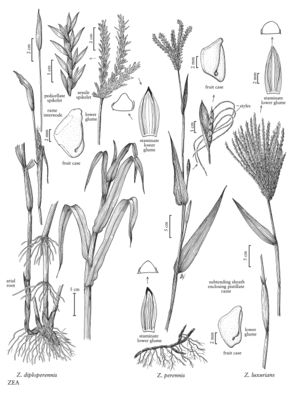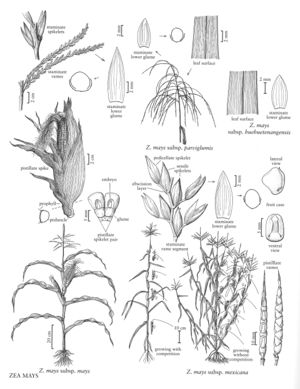Plants annual or perennial; monoecious, inflorescences unisexual or bisexual with the pistillate spikelets basal and the staminate spikelets distal. Culms (0.2) 0.5-6 m tall, 1-5 cm thick, solitary or several to many together, monopodial, often branching (branches frequently highly reduced and hidden within the subtending leaf-sheath), usually succulent when young, becoming woody with age; lower nodes with prop-roots; internodes pith-filled. Leaves not aromatic, cauline, distichous; sheaths open; auricles sometimes present; ligules membranous, shortly ciliate; blades 2-12 cm wide, flat. Pistillate or partially pistillate inflorescences terminal on axillary branches; staminate inflorescences (tassels) paniculate, of 1-many branches or rames, sometimes with secondary and tertiary branching. WILD TAXA: Pistillate inflorescences solitary, distichous rames (ears), these often tightly clustered in false panicles, each usually wholly or partially enclosed by a thin prophyll and an equally thin bladeless leaf-sheath; rames composed of 5-15 spikelets in 2 ranks; disarticulation in the rame axes, dispersal units (fruitcases) consisting of an indurate, shiny rame segment and its embedded spikelet. Pistillate spikelets solitary, sessile, with 1 floret; pedicels and pedicellate spikelets suppressed; lower glumes exceeding the floret, indurate on the central, exposed portion, hyaline on the margins, concealing the caryopses at maturity. DOMESTICATED TAXON: Pistillate inflorescences solitary, polystichous spikes (ears) terminating reduced branches, each spike surrounded by several to many, often bladeless leaf-sheaths and a prophyll (husks), with 60-1000+ spikelets in 8-24 rows, neither spikes nor spikelets disarticulating at maturity. Pistillate spikelets in subsessile pairs, each spikelet with 1 functional floret; glumes shorter than the spikelets, indurate basally, hyaline distally; lower florets suppressed. ALL TAXA: lemmas and paleas hyaline, unawned; lodicules absent; ovaries glabrous; styles (silks) 2, appearing solitary by fused except at the very tip, filamentous, sides stigmatic. Caryopses subspherical to dorsally compressed; hila round; embryos about 2/3 as long as the caryopses. WILD TAXA: Staminate panicles terminal on the culms and primary branches, sometimes also on the secondary branches and pistillate inflorescences; rames distichous, similar in thickness and structure, axes disarticulating below the sessile spikelets after pollination, abscission layers evident. DOMESTICATED TAXON: Staminate panicles terminal on the culms, central axes always much thicker than the lateral branches and irregularly polystichous, lateral branches distichous to more or less polystichous, not disarticulating, without abscission layers below the sessile spikelets. ALL TAXA: Staminate spikelets in sessile-pedicellate pairs, each with 2 staminate florets; glumes membranous to chartaceous, stiff to flexible, sometimes with a pair of winged keels, 5-14 (28) -veined, acute; lemmas and paleas hyaline; lodicules 2; anthers 3. x = 10.
Distribution
Ga., Va., Conn., R.I., Calif., Idaho, Oreg., Wash., Ala., Ark., Colo., Iowa, Ill., Ind., Kans., Ky., La., Mass., Md., Maine, Mich., Minn., Mo., Miss., Mont., N.C., N.H., N.J., N.Mex., N.Y., Ohio, Pa., Puerto Rico, S.C., Tenn., Tex., Utah, Virgin Islands, Vt., Wis., W.Va., Wyo., Ont., Que., Fla., Nebr., Ariz., Nev.
Discussion
Zea is an American genus of five species, four of which are native to montane Mexico and Central America. The fifth species, Z. nicaraguensis H.H. litis & B.F. Benz, is said to have been ubiquitous at one time in coastal Pacific Nicaragua, but is now known from only four or five small populations near sea level in seasonally flooded savannahs and riverine forests inland from the Bay of Fonseca, Nicaragua.
The often weedy, wild taxa, known as 'teosinte', are used in plant breeding as well as in developmental and evolutionary studies. The genus has also been the focus of physiological and genetic research, mostly involving the domesticated taxon, Zea mays subsp. mays. Examples of such work include Barbara McClintock's Nobel prize-winning discovery that genes can "jump" from one chromosome to another, and recent work on the evolution of tassel morphology (e.g., Westerbergh and Doebley 2002).
Zea mays subsp. mays, the most widespread taxon in the genus, was first domesticated about 7,000 years ago and soon became widely planted in the Americas. It is now grown in all warmer parts of the world and is the world's third most important crop plant. No other American grass has such agricultural importance.
In the Flora region, Zea mays subsp. mays is widely grown commercially; Z. luxurians is sometimes grown for forage; while Z. diploperennis and Z. perennis, and the other subspecies of Z. mays, are almost completely confined to research plantings.
Selected References
Lower Taxa
Key
| 1 | Pistillate inflorescences terete, with 2+ rows of paired spikelets, each spikelet with a functional floret, hence the spikelets in 4+ rank; staminate spikelets of wild taxa only slightly imbricate; lower glumes of the staminate spikelets flexible and translucent, loosely enclosing the upper glumes before anthesis, rounded on the back, the lateral veins not more prominent than those between, never forming winged keels; plants annual (sect. Zea) | Zea mays |
| 1 | Pistillate inflorescences somewhat flattened, with 2 rows of solitary spikelets, hence the spikelets appearing 2-ranked; staminate inflorescences with densely imbricate spikelets; lower glumes of the staminate spikelets stiff, not translucent, strongly enclosing the upper glumes before anthesis, with more or less flat backs, the lateral veins evidently more prominent than those between, keeled and winged distally; plants annual or perennial (sect. Luxuriantes). | > 2 |
| 2 | Plants annual; lower glumes of the staminate spikelets narrowly winged; pistillate inflorescence units 1-many per node, usually enclosed by their subtending leaf sheaths, occasionally with 1-2 rames on naked peduncles that exceed the subtending leaf sheaths | Zea luxurians |
| 2 | Plants perennial, rhizomatous; lower glumes of the staminate spikelets strongly winged; pistillate inflorescence units 1-4(5) per node, almost always exceeding the subtending leaf sheaths. | > 3 |
| 3 | Rhizomes to 15 cm long, with internodes 0.2-0.6 cm long, often forming scaly, tuberous short shoots; culms to 3.5 m tall and 3 cm thick; leaf blades to 40 cm long and 4-5.5 cm wide | Zea diploperennis |
| 3 | Rhizomes to 40 cm long or more, with internodes 1-6 cm long, lacking tuberlike shoots; culms to 2.5 m tall and 1.5-2 cm thick; leaf blades often to 65(80) cm long and 2-4.5 cm wide | Zea perennis |
"decumbent" is not a number."thin" is not a number.

